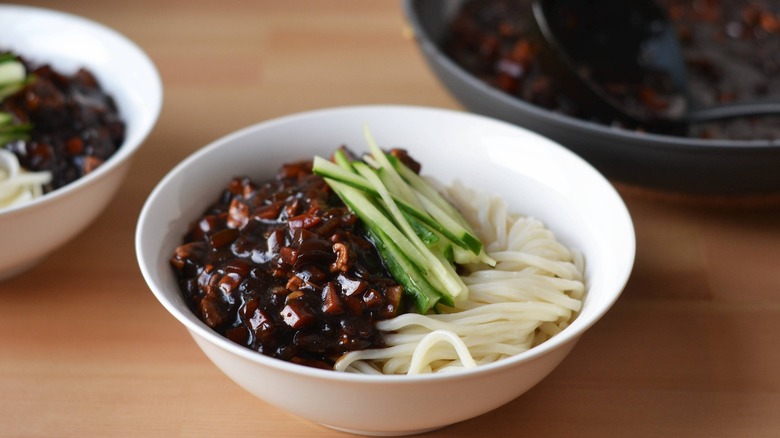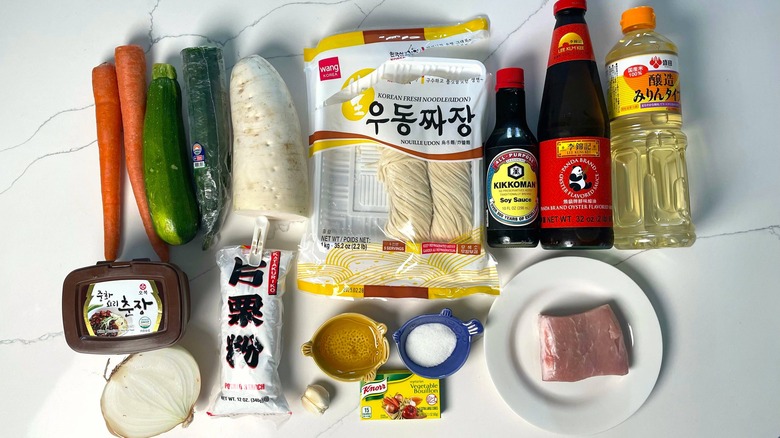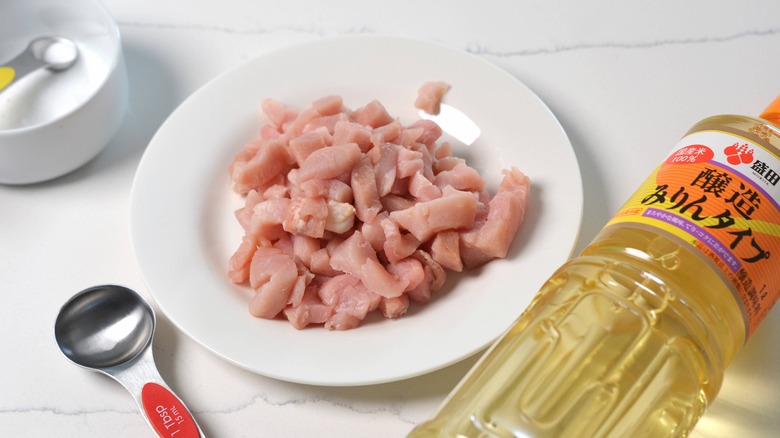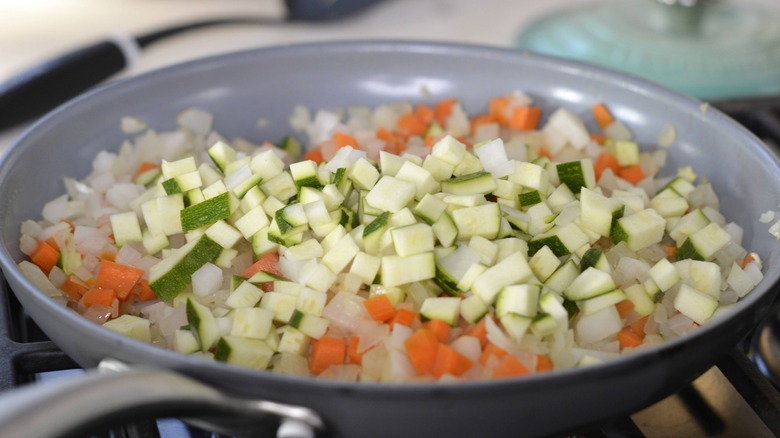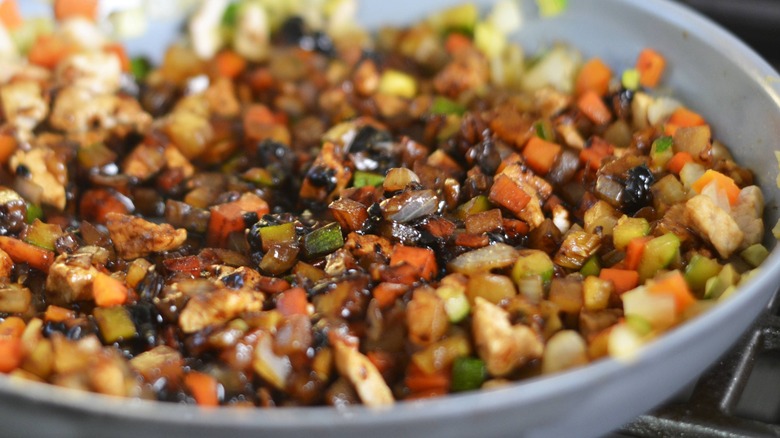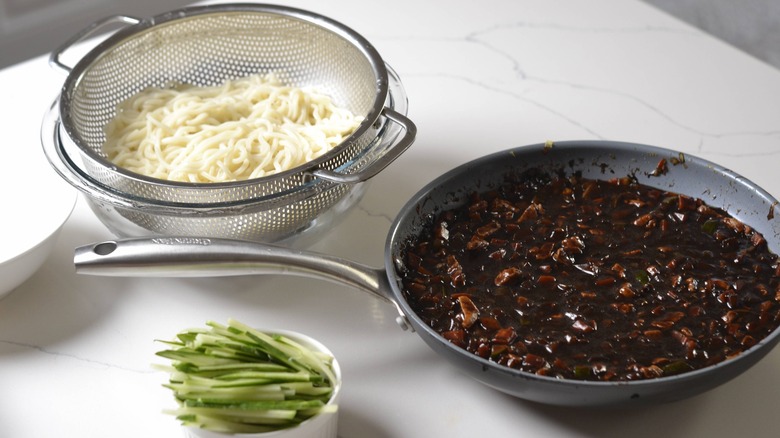Jajangmyeon (Korean Black Bean Noodles) Recipe
Jajangmyeon, a Korean dish with Chinese roots, dates back to the early 20th century but gained popularity during the post-war period when it was seen as being a treat meant for special occasions. Even today, the dish is associated with one particular holiday: Black Day, which is basically a Valentine's Day meant to allow the uncoupled to celebrate their solo status. Appropriately enough, recipe developer Rika Hoffman calls these noodles "Something I would want to devour alone." She describes them as "messy and indulgent and joyful," much like the single life can be.
Hoffman notes that jajangmyeon can be made with any combination of vegetables you have on hand, suggesting cabbage, corn, peas, and potatoes as possible alternates to any of the ones she's using here. In her opinion, though, "Onion is a non-negotiable ingredient [because it is] essential for sweetness." She also admits that her jajangmyeon recipe "isn't spicy at all," but says that if you want a bit more kick to it, you can sprinkle it with gochugaru before digging in.
Gather the ingredients for jajangmyeon (Korean black bean noodles)
For this recipe, Hoffman recommends using Korean wheat noodles, which she says may be labeled as jajangmyeon or udon noodles. She does say, though, that Japanese udon noodles can be used if you can't find the Korean kind. "Although Japanese udon is thicker," she says, "it has a similar chewy texture so it works well in this recipe."
In addition to the noodles, you'll need carrots, zucchini, daikon or Korean radish, onions, garlic, pork loin or belly, mirin, cooking oil, chunjang (Korean black bean paste), sugar, soy sauce, oyster sauce, vegetable broth or bouillon, and potato starch or cornstarch for the sauce. You're also going to need a cucumber to garnish the finished dish.
Prepare the ingredients
Before you can start making the sauce for the noodles, there's a fair bit of prep work to be done. The carrots, daikon, onions, and zucchini all need to be chopped into cubes measuring about ¼ inch on each side. Be sure the peel the onions first, of course, and also peel the garlic before mincing it. Slice the cucumber into julienne strips, then chop up the pork into cubes that are also ¼ inch on each side. Sprinkle the pork with salt and stir in the mirin. The mirin marinade, Hoffman says, "help[s] tenderize the meat and reduce any off-flavors."
The chunjang, too, needs a bit of prepping before you can use it. Mix it with the oil, then stir-fry it over medium heat for 3 minutes. Hoffman explains, "Cooking the chunjang will help reduce the bitterness of the black bean paste."
Cook the vegetables and pork
Pour a bit more oil into a frying pan (not the same one you used for the chunjang), then fry the onions and garlic just until they become aromatic. Add the carrots and daikon and cook these new vegetables for 2 to 3 minutes, then stir in the zucchini and cook it for just a minute more. Remove the vegetables from the pan, then use that same pan to fry the pork. Once it is no longer showing any pink inside, put the vegetables back in the pan and stir-fry everything for a few minutes until the vegetables are cooked. They should still be fairly firm, though.
Make the sauce
Remember that chungyang/oil mixture? Stir that into the pork and vegetables along with the sugar, soy sauce, oyster sauce, and vegetable broth. Mix the starch (potato or corn) with a little water to make a slurry, then stir this into the sauce and cook it for a few minutes until it thickens up a bit. Once the sauce is thick enough, taste it and add as much salt as you'd like.
Add the noodles to finish the dish
Boil a pot of water and cook the noodles according to the instructions on the packaging. Drain and rinse them in cold water to stop the cooking process, then add them to a bowl and top them with the sauce. Scatter the cucumber strips over the top as a garnish. Go ahead and add some gochugaru, too, if you happen to have some on hand and you'd like a little heat.
Hoffman says uneaten jajangmyeon will only last in the refrigerator for a few days, but notes that if you have leftover sauce, it can go into the freezer for longer storage. If you do have some noodles that have been left unsauced, though, you may be interested to know that leftover pasta can actually be frozen as well.
Jajangmyeon (Korean Black Bean Noodles) Recipe
Jajangmyeon is a dish that can be made with any combination of vegetables you have on hand, making it easily accessible for a busy weekday evening.
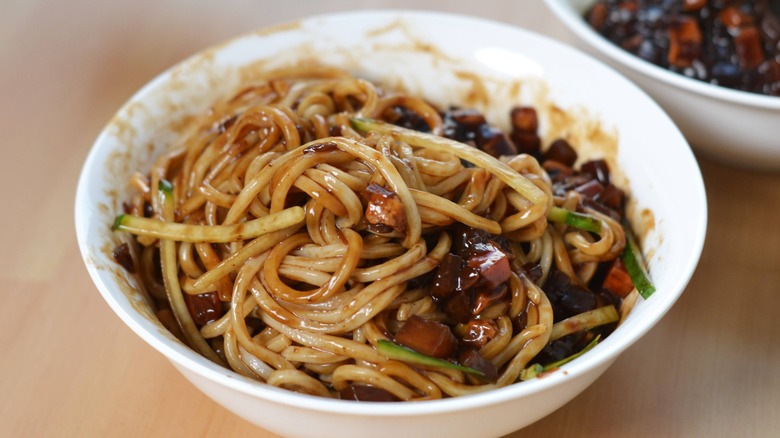
Ingredients
- 1 cup diced carrot
- 1 cup diced zucchini
- 1 cup diced daikon or Korean radish
- 1 ½ cup diced onion
- 3 cloves garlic, minced
- 1 cucumber, juluenned
- 8 ounces of pork loin or belly
- 1 tablespoon mirin
- Salt, to taste
- 2 tablespoons cooking oil
- 5 tablespoons chunjang (Korean black bean paste)
- 1 tablespoon sugar
- 1 tablespoon soy sauce
- 1 tablespoon oyster sauce
- 1 cup vegetable broth or vegetable bouillon dissolved in 1 cup water
- 1 tablespoon potato starch or cornstarch mixed in ¼ cup water
- 17 ½ ounces jajangmyeon or udon noodles
Optional Ingredients
- Gochugaru, to taste
Directions
- Chop the carrot, zucchini, daikon, and onion into ¼ inch cubes.
- Mince the garlic.
- Julienne the cucumber.
- Cut the pork into ¼ inch cubes and season it with mirin and salt.
- Combine the oil and chunjang and cook for 3 minutes over medium heat, stirring constantly.
- Cook the garlic and onion in a separate pan with a small amount of oil until they soften and become fragrant.
- Stir in the carrot and daikon and cook them for 2 to 3 minutes.
- Add the zucchini and cook it for 1 minute, then remove the vegetables from the pan.
- Fry the pork in the same pan until it is no longer pink.
- Return the vegetables to the pan and stir-fry them with the pork for several minutes until they are cooked but still firm.
- Stir the chunjang, sugar, soy sauce, and oyster sauce into the vegetable-pork mixture and add the vegetable broth.
- Stir in the potato starch slurry and cook the sauce until it thickens.
- Salt the sauce to taste.
- Cook the noodles as per package instructions, then drain them and rise them in cold water.
- Serve by topping the noodles with the sauce and cucumber.
- Sprinkle the jajangmyeon with gochugaru if desired.
Nutrition
| Calories per Serving | 1,022 |
| Total Fat | 23.6 g |
| Saturated Fat | 4.9 g |
| Trans Fat | 0.0 g |
| Cholesterol | 47.6 mg |
| Total Carbohydrates | 157.2 g |
| Dietary Fiber | 11.0 g |
| Total Sugars | 19.2 g |
| Sodium | 1,625.7 mg |
| Protein | 43.5 g |
